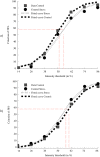The effect of acute social stress on the recognition of facial expression of emotions
- PMID: 28432314
- PMCID: PMC5430718
- DOI: 10.1038/s41598-017-01053-3
The effect of acute social stress on the recognition of facial expression of emotions
Abstract
This study investigates the effect of acute social stress on the recognition of facial expression of emotions in healthy young men. Participants underwent both a standardized psychosocial laboratory stressor (TSST-G) and a control condition. Then, they performed a homemade version of the facial expressions megamix. All six basic emotions were included in the task. First, our results show a systematic increase in the intensity threshold for disgust following stress, meaning that the participants' performance with this emotion was impaired. We suggest that this may reflect an adaptive coping mechanism where participants attempt to decrease their anxiety and protect themselves from a socio-evaluative threat. Second, our results show a systematic decrease in the intensity threshold for surprise, therefore positively affecting the participants' performance with that emotion. We suggest that the enhanced perception of surprise following the induction of social stress may be interpreted as an evolutionary adaptation, wherein being in a stressful environment increases the benefits of monitoring signals indicating the presence of a novel or threatening event. An alternative explanation may derive from the opposite nature of the facial expressions of disgust and surprise; the decreased recognition of disgust could therefore have fostered the propensity to perceive surprise.
Conflict of interest statement
The authors declare that they have no competing interests.
Figures







References
-
- Cannon, W. Bodily Changes in Pain, Hunger, Fear and Rage. (D. Appleton & Company, 1915).
-
- Cannon, W. Wisdom of the Body. (W.W. Norton & Company, 1932).
-
- Taylor SE. Tend and Befriend: Biobehavioral Bases of Affiliation Under Stress. Directions in Psychol Sci. 2006;15:273–277. doi: 10.1111/j.1467-8721.2006.00451.x. - DOI
Publication types
MeSH terms
Substances
LinkOut - more resources
Full Text Sources
Other Literature Sources
Medical

